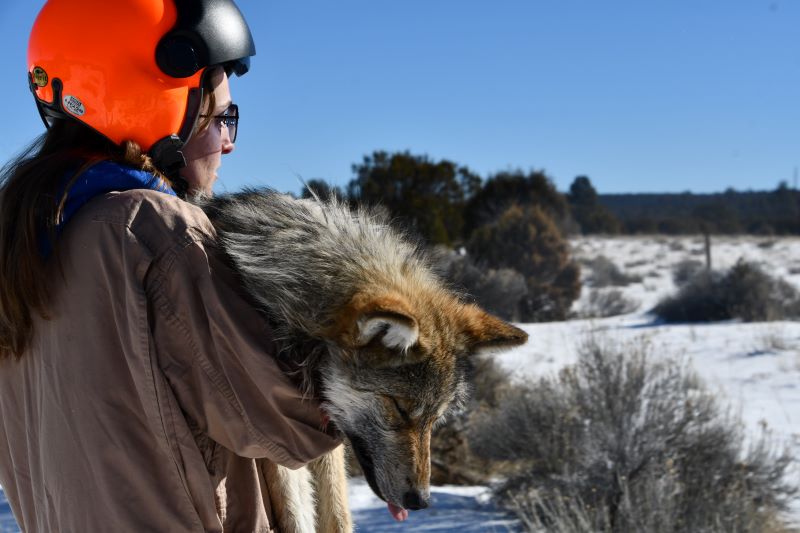
Mexican wolf numbers soar past 200
Mexican wolves were first reintroduced to the wild in the American Southwest 25 years ago, over the objection of ranchers. The 1998 reintroduction marked the first time in 30 years that wild Mexican wolves once again existed within U.S. borders. In late February 2023 – around the time of the 25th anniversary of the reintroduction – the U.S. Fish and Wildlife Service (FWS) and partners appeared to be celebrating the fact that the population of Mexican wolves in Arizona and New Mexico has now surpassed 200.
A minimum of 241 wild wolves were documented in 2022, FWS said in a statement February 28, 2023.
Brady McGee, the recovery coordinator for Mexican wolves, commented:
This milestone has been 25 years in the making. To go from zero wild Mexican wolves at the start to 241 today is truly remarkable. In 2022, we recorded more packs, more breeding pairs, and a growing occupied range, proving we are on the path to recovery.
Captive breeding
At the time the program started, there were only seven remaining Mexican wolves in existence.
Mexican wolves are the rarest subspecies of gray wolf in North America, and they’re listed under the Endangered Species Act. FWS and its partners started a captive breeding program.
Last chance to get a moon phase calendar! Only a few left. On sale now.
Increasing numbers
And now it appears the program is working. Mexican wolf numbers are increasing. In 2021, the team estimated a minimum of 196 wolves. So the estimate of 241 Mexican wolves in 2022 represents a 23% increase.
In fact, it’s the 7th consecutive year of population growth. The number of Mexican wolves in the American Southwest has more than doubled in size since 2017. The team estimates there are 136 wolves in New Mexico and 105 in Arizona.
Jim deVos, Mexican wolf coordinator for the Arizona Game and Fish Department, said:
The road to recovery for any endangered species is neither straight nor easy, and this has proven to be the case for the Mexican wolf. With the stunning growth that occurred in 2022, recovery has accelerated at an amazing rate. By every possible measure, progress was made, including the production from 31 breeding pairs that produced 121 pups, of which 81 were documented to having survived to the time of the count, which is a very high survival rate of 67%. f
How do they count Mexican wolves?
An Interagency Field Team is in charge of counting the Mexican wolf population. The team gathers information from November through February. They choose this time of the year because it’s when the wolf population is most stable. The consistency of this time of year also lets them compare trends from year to year. Their methods consist of conducting ground and aerial surveys, including using remote cameras, scat collection and visual observation.
Learn more here about the where, when, why and how of the U.S. Fish and Wildlife Service’s efforts to capture Mexican wolves.
This year’s findings
The announcement from the U.S. Fish and Wildlife Department highlighted some of the Interagency Field Team’s findings for this year. They counted a minimum of 59 packs: 40 in New Mexico and 19 in Arizona. (A wolf pack is two or more wolves that have an established home range.) They also said a minimum of 121 pups were born in 2022, with at least 81 surviving until the end of the year. That’s a 67% survival rate, higher than the average for Mexican wolf pups in their first year, which is about 50%.
In addition, they reported a minimum of 31 breeding pairs (20 in New Mexico, 11 in Arizona). Lastly, they had 109 collared wolves in the wild at the end of 2021. That’s 45% of the wild population. Stewart Liley, the chief of wildlife for the New Mexico Department of Game and Fish, said:
During this count and capture effort, we were able to capture and radio collar 21 wolves, which will provide a better understanding of wolf activity and help with on the ground wolf management. As we work toward achieving recovery goals, we continue working to build a strong, cooperative team to manage wolves across the range.
Mexican wolf pups join the wild packs
One of the keys to helping the Mexican wolves have a healthy population is the breeding of captive pups and reintroduction of them to the wild. There are 380 Mexican wolves living in more than 60 zoos and conservation centers throughout the U.S. and Mexico. These facilities provide captive-born litters for fostering. This helps to increase genetic diversity in the wild Mexican wolf population.
In 2022, 11 fostered pups joined five wild dens in the Southwest. The team documented that at least two of those pups survived. The total known number of fostered wolves still alive is 14.

Bottom line: Good news for the Mexican wolf population in the American Southwest as the latest count puts them at more than 200, a 23% increase over last year.
Via U.S. Fish and Wildlife Service
Read more: Wolves back in Yellowstone benefit the ecosystem, scientists say











